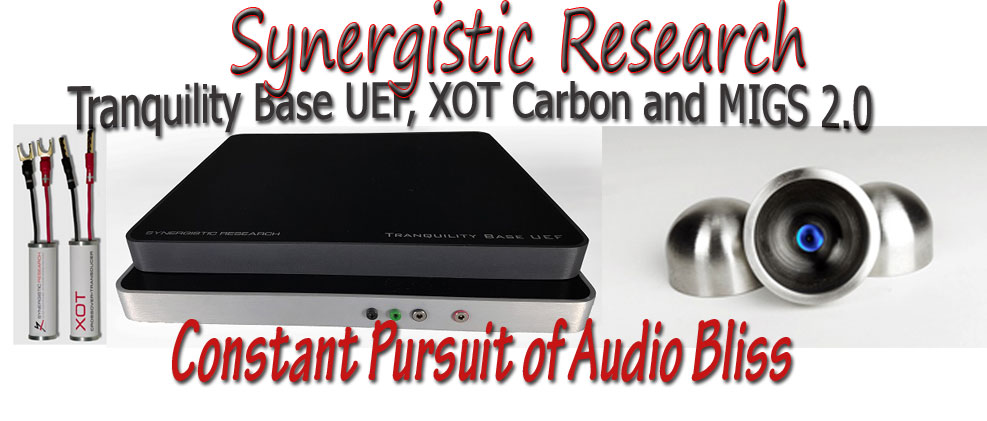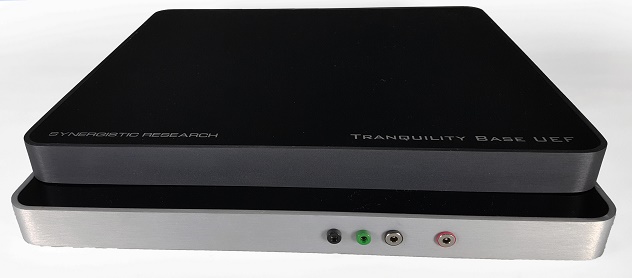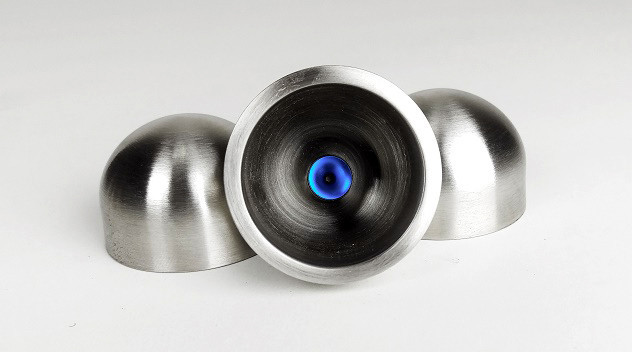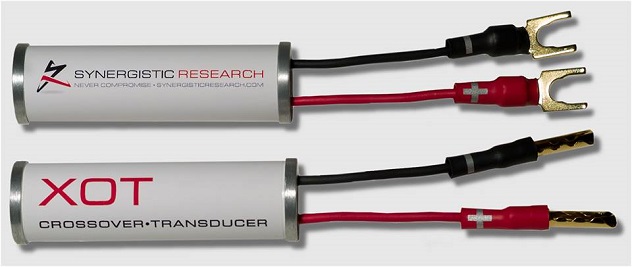Synergistic Research Tranquility Base UEF, XOT Carbon and MIGS 2.0

Tranquility Base UEF
 Back in January 2014, I had the pleasure of reviewing the original Synergistic Research Tranquility Base here. Considering the improvements realized at that time and their award for the Stereo Times Most Wanted Component, it became obvious to me that a follow on review of the latest iteration of the Tranquility Base known as the Tranquility Base UEF was in order.
Back in January 2014, I had the pleasure of reviewing the original Synergistic Research Tranquility Base here. Considering the improvements realized at that time and their award for the Stereo Times Most Wanted Component, it became obvious to me that a follow on review of the latest iteration of the Tranquility Base known as the Tranquility Base UEF was in order.
The original Tranquility Base concept was born from the challenge to improve the performance of computer audio. The approach was to eliminate the interaction between internal components such as power supplies, inductors, IC chips, closely positioned circuits, and printed circuit boards within the computer as opposed to filtering the incoming ac line and line level signals in an effort to lower the noise floor. Application of the Tranquility Base approach was later extended to all audio components. Suggested applications of the TB include turntables, cd players, DACs, transports, computer audio (MAC/PC based servers and hard drives), preamps, external crossovers, amplifiers, and clean power conditioners. The implementation the EM Cell in the Tranquility Base is analogous to the way the patented EM Cell is implemented in the SR PowerCell line conditioner I previously reviewed here.

The Tranquility Base is an engineered platform consisting of a nine-layer laminate with a dark acrylic top and a machined and brushed aluminum base and rim available in natural aluminum and black finishes. An active layer of EM cell is located below the nine layer laminate top. There are three receptacles located on the back panel of the Base which provide the following: a) ground wire provided with its own AC wall plug, b) UEF Enigma Bullets used to fine tune the active sound of the Base (two are provided), and c) power supply known as a Mini Power Coupler (MPC). Six MiGs 2.0 (Mechanical Interface Grounding) footers are included to isolate the component and Base, which I will discuss in more detail below. As with the original Tranquility Base, the Tranquility Base UEF is offered in three different configurations based on size and performance levels. The midlevel Base will be the subject of this review.
Recently Synergistic Research implemented a new material known as graphene in the EM Cell of Tranquility Base UEF. As reported on the Synergistic Research website, “The conductive density of Graphene is the highest of any material currently known to man, making it nearly a “Super Conductor” at room temperature. Confirmation of the unique properties of Graphene can be found easily in a Wikipedia search.

MiG 2.0 (Mechanical Interface Grounding)
The MiG footers are based on the Synergistic Research Acoustic Art System resonator. According to Synergistic Research website, the MiGs “re-tune a component’s mechanical resonance, while providing a lightning fast drain of mechanical energy to ground.” Synergistic Research recommends the placement of the MiGs in two configurations: ambient and pinpoint. The ambient set-up has two MiGs placed under a component “round side up” and one MiG placed “round side down.” The pinpoint set-up has two MiGs placed under a component “round side down” and one MiG placed “round side up”. Starting with your source components (digital or analog) evaluate the two configurations as described above on a component-by-component basis to arrive at optimal placement for your system. MiG 2.0s are 1.65” diameter x 1.09” tall and can be used under transports, DACs, turntables preamplifiers, amplifiers, conditioners, loudspeakers, and subwoofers. MiG 2.0 exclusively incorporate SR’s High Frequency Transducer (HFT) technology on the inside surface of each footer to eliminate high frequency noise; I know of no other footer out there that uses a resonator for this application.

XOT Carbon
Synergistic Research recently introduced an updated version of their loudspeaker Crossover Transducer (XOT) here known as the XOT Carbon. The XOTs are a parallel device inserted between the positive and negative loudspeaker binding posts and are offered in spade and banana connectors. According to Ted Denny, lead designer at Synergistic Research, the UEF technology used in the XOT “actually cleans up high frequency noise that otherwise distorts harmonics in the music signal”. The XOT Carbon high frequency filter exclusively uses Graphene conductors as discussed above contained within a carbon fiber housing.
To maintain consistency within the review, I will begin evaluating the MiG 2.0 under select components replacing the existing MiGs, then I will install the Tranquility Base UEF with supplied MiG 2.0s under my Laufer Teknik Memory Player 64 replacing the existing Tranquility Base, and finally I will replace the existing XOTs I am currently using with XOT Carbons and report on the results.
The Graphene Effect
My reviewing system includes the Laufer Teknik Memory Player 64, Pioneer bdp-09fd blu ray player, Ayon Audio Triton MKIII integrated amplifier fitted with Shuguang Treasure KT-120 power tubes and Radiotechnique signal tubes, Acoustic Zen Crescendo loudspeakers, REL R-528SE subwoofer, SR Atmosphere Level 4 speaker cables and interconnects, SR Tesla LE REL SPEC Subwoofer Reference cable, SR Element power cords, SR PowerCell 10 UEF conditioner, SR FEQ PowerCell Equalizer, SR Tesla Plex SE outlets, SR HFTs, SR Atmosphere, SR ATM, SR FEQs, SR UEF XOTs, SR UEF power cable tuning circuits, SR Grounding Block and HDG cables, SR Black Box, SR MiGs and SR Tranquility Bases. As for my listening area, its 14.5’ wide, has a 9’ ceiling, and has an open back wall to 1500 sq ft of first floor living area.
When I replaced the original MiG footers with the latest MIG 2.0 footers under my Ayon Audio Triton MKII integrated amplifier, Pioneer Elite Blu-ray player, and then under my SR PowerCell 10 UEF conditioner the improvement was immediate and quite noticeable. Listening to one of my favorite recordings, the second cut, Chitlins Con Carne on the album The Anthony Wilson Trio, Our Gang (Groove Note), each instrument displayed a greater sense of space and depth within the soundstage. I preferred the pitch definition and control I now heard on the base guitar while the electric guitar was more clearly portrayed with the MiG 2.0s. Also, with each strike on the drums and cymbals, I now heard longer decays. I particularly noticed how the electric organ when hitting the higher frequency notes sounded less strained adding to the enjoyment of this cut. I’ve had my share of footers over the years but in comparison, the Synergistic Research MiG 2.0s are a must have component and well worth the price of admission.
 New Moon Daughter is a studio album by American jazz singer Cassandra Wilson. Cassandra tackles a wide variety of pieces from diverse sources such as Son House, Neil Young, Johnny Mercer, Billie Holiday, and the Monkees in this recording. With its pared-down, simple arrangements, Cassandra’s voice is spotlighted by acoustic guitar and percussion, with highlights of cornet and pedal steel providing this recording with a live and intimate feel. It was easy to hear the how the essence of music was transformed when the Tranquility Base UEF was installed in my system … within 30 seconds I knew I wanted to add another Tranquility Base UEF under my Ayon Audio Triton MKIII integrated amplifier. The Tranquility Base UEF again distinguished itself in the most important area, the midrange. With the Tranquility Base UEF employed, Cassandra’s voice was more captivating, more natural, and filled the room to a much greater extent as compared to the original Tranquility Base. With the lower noise floor imparted to my computer based digital system (Laufer Teknik Memory Player 64) by the Tranquility Base UEF, all instruments projected further into the room with the surrounding ambience having greater clarity. The sound from my Acoustic Zen Crescendos loudspeakers appeared less localized and sounded louder at the same volume setting. Even with the image of each instrument projected further into the room, it was easier to locate individual instruments within the soundstage in the front to back plane while fostering a sense of nothing between you and the music. In terms of upgrades from one model to the next, it was big.
New Moon Daughter is a studio album by American jazz singer Cassandra Wilson. Cassandra tackles a wide variety of pieces from diverse sources such as Son House, Neil Young, Johnny Mercer, Billie Holiday, and the Monkees in this recording. With its pared-down, simple arrangements, Cassandra’s voice is spotlighted by acoustic guitar and percussion, with highlights of cornet and pedal steel providing this recording with a live and intimate feel. It was easy to hear the how the essence of music was transformed when the Tranquility Base UEF was installed in my system … within 30 seconds I knew I wanted to add another Tranquility Base UEF under my Ayon Audio Triton MKIII integrated amplifier. The Tranquility Base UEF again distinguished itself in the most important area, the midrange. With the Tranquility Base UEF employed, Cassandra’s voice was more captivating, more natural, and filled the room to a much greater extent as compared to the original Tranquility Base. With the lower noise floor imparted to my computer based digital system (Laufer Teknik Memory Player 64) by the Tranquility Base UEF, all instruments projected further into the room with the surrounding ambience having greater clarity. The sound from my Acoustic Zen Crescendos loudspeakers appeared less localized and sounded louder at the same volume setting. Even with the image of each instrument projected further into the room, it was easier to locate individual instruments within the soundstage in the front to back plane while fostering a sense of nothing between you and the music. In terms of upgrades from one model to the next, it was big.
 The album Gold by Bob Marley & the Wailers (Island Records) has been receiving its share of playtime as of late. Gold is a two-disc compilation album by Bob Marley and the Wailers that was remastered and released on the Island Records label in 2005. The compilation is intended to be a career-spanning retrospective, and no fewer than two songs are selected from each of Bob Marley and the Wailers’ albums with the company. Songs range from his first album for the label, Catch a Fire, and span all the way through to the last album Marley would live to see released in his lifetime, Uprising, concluding with the posthumous releases “Iron Lion Zion,” and tracks from Confrontation. Listening to the first cut, Stir It Up, I immediately noticed a significant improvement in the quality of the base with each base note having greater clarity while being more enveloping within my room when the Tranquility Base UEF was installed. The sheer quality of the base was also closer to what you would hear in an intimate jazz setting versus a reproduction by a high-end stereo system. Again, my Acoustic Zen Crescendos loudspeakers also disappeared better and my system sounded louder at the same volume setting. What really struck me was how individual notes played by each instrument had greater clarity with each note having a beginning and ending that was more easily discerned. Once you hear how much better the Tranquility Base UEF is over the original Tranquility Base, it’s hard to go back.
The album Gold by Bob Marley & the Wailers (Island Records) has been receiving its share of playtime as of late. Gold is a two-disc compilation album by Bob Marley and the Wailers that was remastered and released on the Island Records label in 2005. The compilation is intended to be a career-spanning retrospective, and no fewer than two songs are selected from each of Bob Marley and the Wailers’ albums with the company. Songs range from his first album for the label, Catch a Fire, and span all the way through to the last album Marley would live to see released in his lifetime, Uprising, concluding with the posthumous releases “Iron Lion Zion,” and tracks from Confrontation. Listening to the first cut, Stir It Up, I immediately noticed a significant improvement in the quality of the base with each base note having greater clarity while being more enveloping within my room when the Tranquility Base UEF was installed. The sheer quality of the base was also closer to what you would hear in an intimate jazz setting versus a reproduction by a high-end stereo system. Again, my Acoustic Zen Crescendos loudspeakers also disappeared better and my system sounded louder at the same volume setting. What really struck me was how individual notes played by each instrument had greater clarity with each note having a beginning and ending that was more easily discerned. Once you hear how much better the Tranquility Base UEF is over the original Tranquility Base, it’s hard to go back.
 Lastly, I attached two pairs of Synergistic Research XOT Carbon high frequency crossover filters to high and low-frequency binding posts of my Acoustic Zen Crescendo loudspeakers and allowed for a 96 hour break-in period. I used various cuts from The Anthony Wilson Trio album, Our Gang (Groove Note) to determine the improvements over the original Synergistic Research XOTs. The more efficient high frequency filtration exerted by the XOT Carbons added even more depth and better separation of instruments. I could pick out the trio of guitars more readily; the electric organ was more fleshed out, occupied a larger space, and sounded more natural at the higher frequencies with the XOT Carbons in place. This was completely addictive to how the SR Tranquility Base UEF and MIG 2.0s improved my system. At one point I decided to remove the XOT Carbons from my system but quickly discovered my previous observations were validated proving to me the advantages of Graphene conductors.
Lastly, I attached two pairs of Synergistic Research XOT Carbon high frequency crossover filters to high and low-frequency binding posts of my Acoustic Zen Crescendo loudspeakers and allowed for a 96 hour break-in period. I used various cuts from The Anthony Wilson Trio album, Our Gang (Groove Note) to determine the improvements over the original Synergistic Research XOTs. The more efficient high frequency filtration exerted by the XOT Carbons added even more depth and better separation of instruments. I could pick out the trio of guitars more readily; the electric organ was more fleshed out, occupied a larger space, and sounded more natural at the higher frequencies with the XOT Carbons in place. This was completely addictive to how the SR Tranquility Base UEF and MIG 2.0s improved my system. At one point I decided to remove the XOT Carbons from my system but quickly discovered my previous observations were validated proving to me the advantages of Graphene conductors.
Conclusion
The use of Graphene conductors is finding its way into many audio applications (fuses, ac power cords, power conditioner, signal cables, component isolation bases and crossover filters). On both the Synergistic Research Tranquility Base UEF and XOT Carbons products, the employment of Graphene did not add its own flavor to the music but tended to enhance the separation and depth of instruments while improving the transparency. Although each product stands on its own, of the three components reviewed, the Synergistic Research Tranquility Base UEF had the greatest impact on the musicality of my system. As with the other Synergistic Research products I’ve reviewed over the years there is definitely a “synergy” going on here, with each component addition building on the next in the pursuit of the absolute sound. Highly recommended.


Mike Girardi
Specifications:
MiG 2.0, $249
Tranquility Base UEF, $2250
XOT Carbon (pair), $449 per pair
Website: www.synergisticresearch.com
Phone numbers: (800) 578-6489 within US and (949) 476-0000 outside the US
Stereo Times Masthead
Publisher/Founder
Clement Perry
Editor
Dave Thomas
Senior Editors
Frank Alles, Mike Girardi, Russell Lichter, Terry London, Moreno Mitchell, Paul Szabady, Bill Wells, Mike Wright, and Stephen Yan,
Current Contributors
David Abramson, Tim Barrall, Dave Allison, Ron Cook, Lewis Dardick, John Hoffman, Dan Secula, Don Shaulis, Greg Simmons, Eric Teh, Greg Voth, Richard Willie, Ed Van Winkle, Rob Dockery, Richard Doran, and Daveed Turek
Site Management Clement Perry
Ad Designer: Martin Perry





Be the first to comment on: Synergistic Research Tranquility Base UEF, XOT Carbon and MIGS 2.0